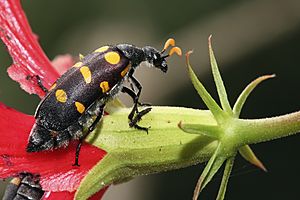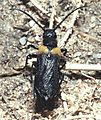Blister beetle facts for kids
Quick facts for kids Blister beetles |
|
|---|---|
 |
|
| Hycleus lugens: This beetle has bright colors that warn predators. | |
| Scientific classification |
|
| Kingdom: | Animalia |
| Phylum: | Arthropoda |
| Class: | Insecta |
| Order: | Coleoptera |
| Family: | Meloidae Gyllenhaal, 1810 |
| Subfamilies | |
|
Eleticinae |
|
Blister beetles are a special type of beetle belonging to the family called Meloidae. They are known for a unique chemical they produce. This chemical, called cantharidin, can cause blisters if it touches your skin. It's like a small bubble that forms on your skin.
There are about 7,500 different kinds of blister beetles found all over the world. These beetles are poisonous to animals that try to eat them. This helps them stay safe from predators.
Contents
What Makes Blister Beetles Special?
Blister beetles have a very interesting life cycle. They go through several larval stages. This means they change their shape many times as they grow.
How Blister Beetles Grow
Unlike many insects, blister beetles have a complex life cycle called hypermetamorphosis. Their larvae look very different in each stage. The first larval stage is often called a "triungulin." These tiny larvae are very active. They often wait on flowers to hitch a ride.
What Do Blister Beetles Eat?
Young blister beetle larvae mainly attack bees. They sneak into bee nests and eat the bee larvae and their food. Some types of blister beetle larvae also eat grasshopper eggs. Adult blister beetles usually eat plants. They are often found on alfalfa and weeds when these plants are flowering.
Blister Beetles and Their Defense
The chemical cantharidin is the main way blister beetles protect themselves. When a beetle feels threatened, it can release this oily liquid. This liquid causes blisters on the skin of animals that touch it. It can also be very irritating if it gets into the eyes or mouth.
Why They Are Poisonous
Blister beetles are poisonous to many animals, including birds and mammals. If an animal eats a blister beetle, the cantharidin can make them very sick. This strong defense helps the beetles survive in nature.
Images for kids
-
Ivy bee (Colletes hederae), carrying tiny parasitic larvae of Stenoria analis
-
Cysteodemus armatus in the Mojave Desert: The white coating is a natural wax.
See also
 In Spanish: Meloidos para niños
In Spanish: Meloidos para niños










